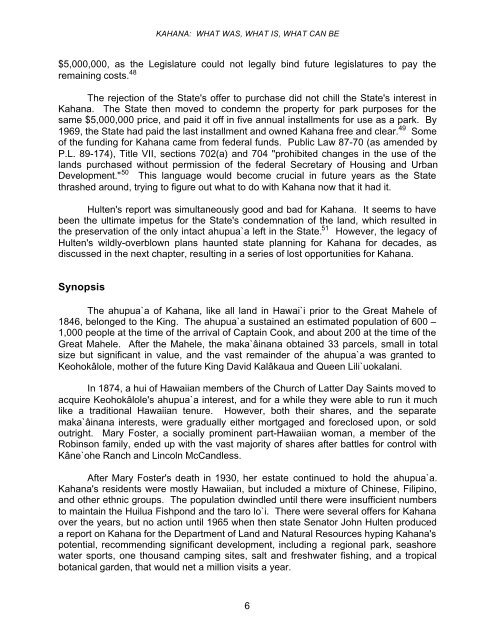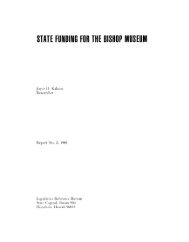Kahana: what was, what is, what can be. - Legislative Reference ...
Kahana: what was, what is, what can be. - Legislative Reference ...
Kahana: what was, what is, what can be. - Legislative Reference ...
You also want an ePaper? Increase the reach of your titles
YUMPU automatically turns print PDFs into web optimized ePapers that Google loves.
KAHANA: WHAT WAS, WHAT IS, WHAT CAN BE<br />
$5,000,000, as the Leg<strong>is</strong>lature could not legally bind future leg<strong>is</strong>latures to pay the<br />
remaining costs. 48<br />
The rejection of the State's offer to purchase did not chill the State's interest in<br />
<strong>Kahana</strong>. The State then moved to condemn the property for park purposes for the<br />
same $5,000,000 price, and paid it off in five annual installments for use as a park. By<br />
1969, the State had paid the last installment and owned <strong>Kahana</strong> free and clear. 49 Some<br />
of the funding for <strong>Kahana</strong> came from federal funds. Public Law 87-70 (as amended by<br />
P.L. 89-174), Title VII, sections 702(a) and 704 "prohibited changes in the use of the<br />
lands purchased without perm<strong>is</strong>sion of the federal Secretary of Housing and Urban<br />
Development." 50 Th<strong>is</strong> language would <strong>be</strong>come crucial in future years as the State<br />
thrashed around, trying to figure out <strong>what</strong> to do with <strong>Kahana</strong> now that it had it.<br />
Hulten's report <strong>was</strong> simultaneously good and bad for <strong>Kahana</strong>. It seems to have<br />
<strong>be</strong>en the ultimate impetus for the State's condemnation of the land, which resulted in<br />
the preservation of the only intact ahupua`a left in the State. 51 However, the legacy of<br />
Hulten's wildly-overblown plans haunted state planning for <strong>Kahana</strong> for decades, as<br />
d<strong>is</strong>cussed in the next chapter, resulting in a series of lost opportunities for <strong>Kahana</strong>.<br />
Synops<strong>is</strong><br />
The ahupua`a of <strong>Kahana</strong>, like all land in Hawai`i prior to the Great Mahele of<br />
1846, <strong>be</strong>longed to the King. The ahupua`a sustained an estimated population of 600 –<br />
1,000 people at the time of the arrival of Captain Cook, and about 200 at the time of the<br />
Great Mahele. After the Mahele, the maka`âinana obtained 33 parcels, small in total<br />
size but signifi<strong>can</strong>t in value, and the vast remainder of the ahupua`a <strong>was</strong> granted to<br />
Keohokâlole, mother of the future King David Kalâkaua and Queen Lili`uokalani.<br />
In 1874, a hui of Hawaiian mem<strong>be</strong>rs of the Church of Latter Day Saints moved to<br />
acquire Keohokâlole's ahupua`a interest, and for a while they were able to run it much<br />
like a traditional Hawaiian tenure. However, both their shares, and the separate<br />
maka`âinana interests, were gradually either mortgaged and foreclosed upon, or sold<br />
outright. Mary Foster, a socially prominent part-Hawaiian woman, a mem<strong>be</strong>r of the<br />
Robinson family, ended up with the vast majority of shares after battles for control with<br />
Kâne`ohe Ranch and Lincoln McCandless.<br />
After Mary Foster's death in 1930, her estate continued to hold the ahupua`a.<br />
<strong>Kahana</strong>'s residents were mostly Hawaiian, but included a mixture of Chinese, Filipino,<br />
and other ethnic groups. The population dwindled until there were insufficient num<strong>be</strong>rs<br />
to maintain the Huilua F<strong>is</strong>hpond and the taro lo`i. There were several offers for <strong>Kahana</strong><br />
over the years, but no action until 1965 when then state Senator John Hulten produced<br />
a report on <strong>Kahana</strong> for the Department of Land and Natural Resources hyping <strong>Kahana</strong>'s<br />
potential, recommending signifi<strong>can</strong>t development, including a regional park, seashore<br />
water sports, one thousand camping sites, salt and freshwater f<strong>is</strong>hing, and a tropical<br />
botanical garden, that would net a million v<strong>is</strong>its a year.<br />
6
















